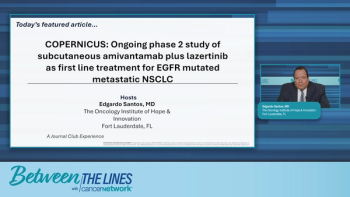
A Review of the Data from the HER2CLIMB-04 and TUXEDO-1 Trials
Reshma Mahtani, DO, and Neil Iyengar, MD, discuss the data presented at ESMO 2021 in the TUXEDO-1 and HER2CLIMB-04 trials.
Episodes in this series

Sara Hurvitz, MD:Let’s move on to another question: how do we change therapy based on location of disease? Do central nervous system [CNS] metastases change how we treat systemically? There hasn’t been many drugs looked at in active brain metastases. We have tucatinib available for patients with active and progressing CNS metastases. We know brain metastases are common—30% to 50% of patients with HER2 [human epidermal growth factor receptor 2]–positive metastatic breast cancer will develop CNS metastases, and there were several posters presented at ESMO [European Society for Medical Oncology Annual Meeting]. Dr Mahtani, can you discuss the TUXEDO trials? Early evidence was presented relating to this, and I found it very compelling even though it was just a few patients.
Reshma Mahtani, DO:To reiterate your comments, when brain metastases occur in HER2+ metastatic breast cancer, patients can suffer devastating consequences related to quality of life for themselves and their families. Trastuzumab deruxtecan is this novel antibody-drug conjugate [ADC] that’s shown activity in heavily pretreated patients. With the recent data that we looked at with DB03 [letrozole], this stands to change the treatment paradigm in the second-line setting. We have little data on the activity of this therapy in the CNS in patients with active brain metastases. Unlike in the HER2CLIMB data set, where patients with active brain metastases were permitted to enroll, here we only have data with patients with stable brain metastases. In DESTINY-Breast01 that was about 24 patients. There was a response rate seen in the CNS, but that’s under the condition that those are related to prior radiation that was completed 60 days before enrollment in that trial.
At ESMO, we heard preliminary data from the prospective single-arm phase 2 TUXEDO trial, looking at T-DXd [trastuzumab deruxtecan] in patients with HER2+ metastatic breast cancer with active brain metastases. These patients had newly diagnosed brain metastases, or brain metastases with radiologic progression. After prior local therapy, they were exposed to trastuzumab and pertuzumab and had no indication for immediate local therapy. The primary end point was intracranial response rate. This was a Simon Design 2-stage phase 2 design. We have small numbers at a median follow-up of about 3½ months. Nine patients were still on treatment, and there was an intracranial response in 5 of 6 patients, which is 83.3%. Based on these results, the trial has progressed to the second stage. We’re beginning to sense that some of these ADCs may have activity in patients with brain metastases. The data with T-DM1 [trastuzumab emtansine] also hinted at activity in the brain for these ADCs.
Sara Hurvitz, MD:These are compelling data, and I’m excited to see this move into stage 2. Gone are the days where we assume that because a molecule is bulky, like ADCs, that they can’t penetrate the blood-brain barrier. In patients who had surgery or radiation, that blood-brain barrier is likely not as intact. There was another ongoing study in terms of CNS metastases that I’d like to discuss briefly, before we discuss the clinical implications of these data. Dr Iyengar, can you briefly review the ongoing and lesser-known study called HER2CLIMB-04?
Neil Iyengar, MD:This was a trial in progress presented at ESMO, with no data yet, but it’s useful to be aware of this ongoing study. It’s a single-arm phase 2 open-label trial that evaluates the safety and efficacy of the combination of tucatinib plus trastuzumab deruxtecan in HER2+ metastatic breast cancer. This is specifically in patients who have received 2 or more prior HER2 base regimens in the metastatic setting. When the trial was designed, the intention was to test the combination of tucatinib and trastuzumab deruxtecan in the third line and beyond. Now that we have the DESTINY-Breast03 trial and trastuzumab deruxtecan moving into the second-line setting, we’ll have to reevaluate how we interpret this trial. This combination is interesting. Patients with brain metastases, including active brain metastases, are allowed to be enrolled on HER2CLIMB-04. There is a safety run-in period of about 10 patients to test the safety of the combination. If acceptable, then the trial will move on and enroll 60 patients. These 60 patients are intended to be distributed evenly among patients with and without brain metastases. The primary end point of the trial is confirmed objective response rate, and secondary end points are progression-free survival, duration of response, disease control rate, overall survival, and safety. The trial began enrolling in early 2020, so hopefully we’ll see updates or results soon.
Sara Hurvitz, MD:I’m excited to see that combination. We also have the HER2CLIMB-02 trial ongoing, which is T-DM1 [trastuzumab emtansine] with or without tucatinib. That’s close to completing enrollment, if the rumors are true, so we’ll have some interesting additional data for our patients with brain metastases.
This transcript has been edited for clarity.
Newsletter
Stay up to date on recent advances in the multidisciplinary approach to cancer.




































































































